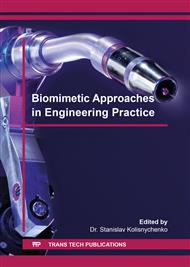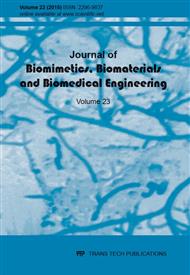[1]
Y. Bar-Cohen, Int. J. Aeronautical Space Sci. 13 (1) (2012) 1–13.
Google Scholar
[2]
Jeon J H, Yeom S-W and Oh I-K 2008 Fabrication and actuation of ionic polymer metal composites patterned by combining electroplating with electroless plating Composites A 39 588–96.
DOI: 10.1016/j.compositesa.2007.07.013
Google Scholar
[3]
Kim K J, Pugal D and Leang K K 2011 A twistable ionic polymer–metal composite artificial muscle for marine applications Mar. Technol. Soc. J. 45 83–98.
DOI: 10.4031/mtsj.45.4.9
Google Scholar
[4]
N. S. Ha, N. S. Goo, Propulsion Modeling and Analysis of a Biomimetic Swimmer, Journal of Bionic Engineering, Vol. 7, p.259– 266, (2010).
DOI: 10.1016/s1672-6529(10)60249-1
Google Scholar
[5]
A. Crespi, A. Badertscher, A. Guignard, A. J. Ijspeert, AmphiBot I: an amphibious snake-like robot, Robotics and Autonomous Systems, Vol. 50, No. 4, pp.163-175, (2005).
DOI: 10.1016/j.robot.2004.09.015
Google Scholar
[6]
M. Mori, S. Hirose, Locomotion of 3D Snake-Like Robots - Shifting and Rolling Control of Active Cord Mechanism ACM-R3 –, Journal of Robotics and Mechatronics, Vol. 18, No. 5, pp.521-528, (2006).
DOI: 10.20965/jrm.2006.p0521
Google Scholar
[7]
L. Shi, S. Guo, M. Li, S. Mao, N. Xiao, B. Gao, Z. Song, and K. Asaka, A Novel Soft Biomimetic Microrobot with Two Motion Attitudes, Sensors, Vol. 12, No. 12, pp.16732-16758, (2012).
DOI: 10.3390/s121216732
Google Scholar
[8]
B. Behkam, and M. Sitti, Design methodology for biomimetic propulsion of miniature swimming robots, Journal of Dynamic Systems, Measurement, and Control, Vol. 128, No. 1, pp.36-43, (2006).
DOI: 10.1115/1.2171439
Google Scholar
[9]
W. Zhang, S. Guo and K. Asaka, A New Type of Hybrid Fish-like Microrobot, International Journal of Automation and Computing, Vol. 3, No. 4, pp.358-365, (2006).
DOI: 10.1007/s11633-006-0358-4
Google Scholar
[10]
L. Shi, S. Guo, K. Asaka, A bio-inspired underwater microrobot with compact structure and multifunctional locomotion, in: Proceedings of 2011 IEEE/ASME International Conference on Advanced Intelligent Mechatronics, AIM 2011, Budapest, Hungary, 2011, p.203.
DOI: 10.1109/aim.2011.6026989
Google Scholar
[11]
S. Heo, T. Wiguna, H. Park, N. Goo, Effect of an artificial caudal fin on the performance of a biomimetic fish robot propelled by piezoelectric actuators, Journal of Bionic Engineering 4 (3) (2007) 151–158.
DOI: 10.1016/s1672-6529(07)60027-4
Google Scholar
[12]
Z. Wang, G. Hang, J. Li, Y. Wang, K. Xiao, A micro-robot fish with embedded SMA wire actuated flexible biomimetic fin, Sensors and Actuators A: Physical 144(2)(2008)354–360.
DOI: 10.1016/j.sna.2008.02.013
Google Scholar
[13]
S. Yeom, I. Oh, A biomimetic jellyfish robot based on ionic polymer metal composite actuators, Journal of Smart Materials and Structures 18 (2009) 1–16.
DOI: 10.1088/0964-1726/18/8/085002
Google Scholar
[14]
JoelJ. Hubbard, Maxwell Fleming, Viljar Palmre, David Pugal, KwangJ. Kim, and KamK. Leang, Monolithic IPMC Fins for Propulsion and Maneuvering in Bioinspired Underwater Robotics , IEEE JOURNAL OF OCEANIC ENGINEERING, VOL. 39, NO. 3, JULY (2014).
DOI: 10.1109/joe.2013.2259318
Google Scholar
[15]
Viljar Palmre, Joel J Hubbard, Maxwell Fleming, David Pugal, Sungjun Kim, Kwang J Kim and Kam K Leang, An IPMC-enabled bio-inspired bending/twisting fin for underwater applications, IOP PUBLISHING SMART MATERIALS AND STRUCTURES, Smart Mater. Struct. 22 (2013).
DOI: 10.1088/0964-1726/22/1/014003
Google Scholar
[16]
Muhammad Farid, Zhao Gang, Tran Linh Khuong, Zhuang-ZHI Sun, Forward Kinematic modeling and simulation of Ionic Polymer Metal Composites (IPMC) actuators for bionic knee joint, Advanced Materials Research Vols. 889-890 (2014) pp.938-941.
DOI: 10.4028/www.scientific.net/amr.889-890.938
Google Scholar
[17]
Viljar Palmre, David Pugal, and Kwang Kim, Characterization of longitudinal tensile force of millimeter thick IPMCs , Electroactive Polymer Actuators and Devices (EAPAD) 2012, Proc. of SPIE Vol. 8340, 83402L.
DOI: 10.1117/12.915925
Google Scholar



